
Understanding your hip measurement goes beyond simply determining your physical health. It serves as a valuable tool in assessing your overall fitness progress and even plays a role in gauging your physical attractiveness. By knowing the average hip size for women, men, teenagers, and children, you gain insight into your body’s unique composition and how it relates to your well-being.
In this comprehensive guide, we not only provide instructions on how to accurately measure your hips but also address common queries surrounding this topic. Moreover, we delve into the average hip measurements for both males and females across different age groups, offering a broader perspective on body proportions and development.
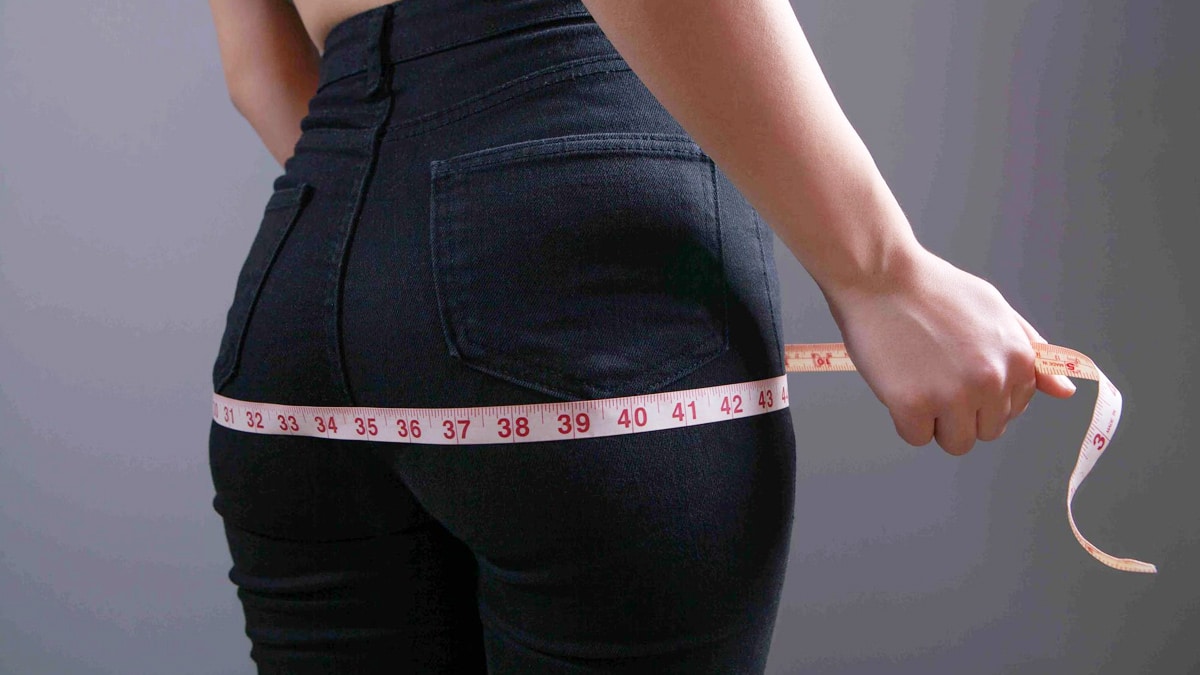
By familiarizing yourself with these average measurements, you can better understand how your own hip size compares to the norm. This knowledge enables you to set realistic goals for fitness and health, providing a solid foundation for self-improvement and personal growth.
See How Your Hips Compare:
- 30 inch hips
- 31 inch hips
- 32 inch hips
- 33 inch hips
- 34 inch hips
- 35 inch hips
- 36 inch hips
- 37-inch hips
- 38 inch hips
- 39 inch hips
- 40 inch hips
- 41 inch hips
- 42 inch hips
- 43 inch hips
- 44 inch hips
- 45 inch hips
- 46 inch hips
- 47 inch hips
- 48 inch hips
- 49 inch hips
- 50 inch hips
- 60 inch hips
Contents
- What is the average hip size for women?
- What is the average hip size for men?
- What is the average hip circumference for teenage girls?
- What is the average hip circumference for teenage boys?
- What is the average hip width for women?
- What is the average male hip width?
- Hip size charts
- Female hip size chart (clothing)
- Hip size chart for women (circumference)
- Male hip size chart (circumference)
- Female hip width size chart
- Male hip width chart
- How to measure your hips (circumference)?
- How to measure your hip width?
- Hip measurement FAQ
- What is the hip size?
- Is there such a thing as the perfect hip size for a woman?
- What is the ideal hip size for a 5’5″ woman?
- What is a healthy hip size?
- Where should you measure your hips?
- What is the difference between a hip-width measurement and a hip circumference measurement?
- Should you measure men’s hips and women’s hips differently?
- How can you measure your hips without a tape measure?
- What is the average hip size by height?
- Should you aim for a normal hip measurement?
- Conclusion
- References
- Related
What is the average hip size for women?
The average hip size for women can vary depending on various factors such as ethnicity, geographical location, and overall body composition. However, it’s important to note that beauty and body standards differ across cultures, and there is no one-size-fits-all answer to this question.
In general, anthropometric studies have shown that the average hip circumference for women tends to fall within a range of approximately 36 to 40 inches (91 to 101 cm). These measurements are based on a diverse sample of women from different populations.
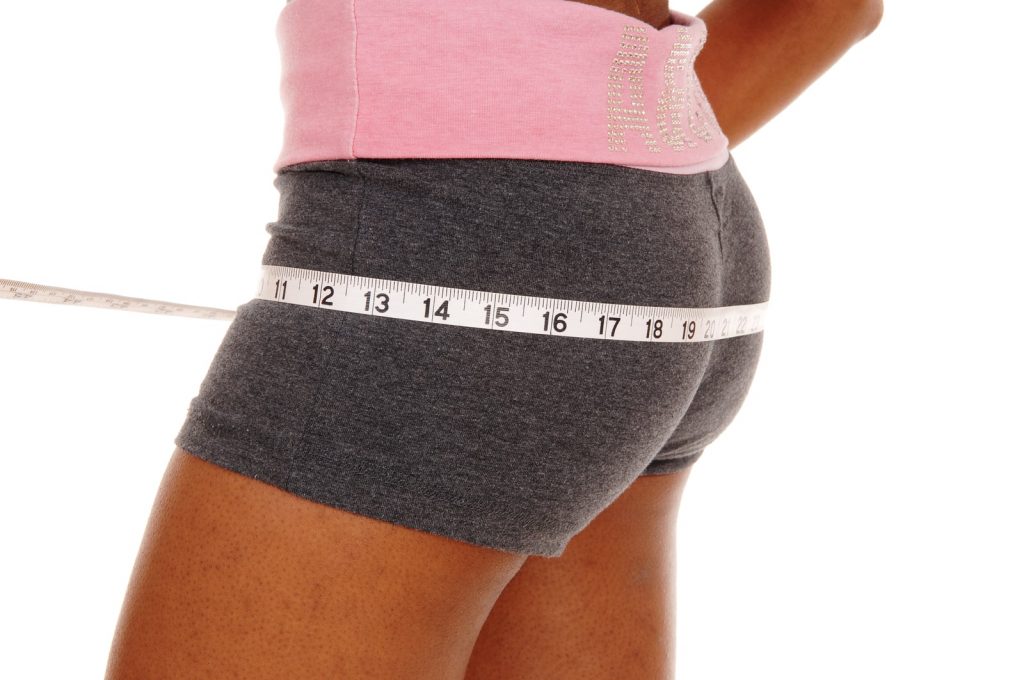
It’s crucial to remember that every individual’s body is unique, and there is a wide range of body shapes and sizes that are considered healthy and beautiful. It’s more important to focus on overall well-being, including maintaining a healthy weight, engaging in regular physical activity, and embracing body positivity, rather than obsessing over specific measurements or conforming to societal expectations.
Related Measurement Guides:
- Average butt size
- Average height for women
- Average female BMI
- Average women’s waist size
- Average wrist size for women
- Average human shoulder width
- Average arm circumference for females
- Average forearm measurement
- Average female thigh circumference
- Average calf circumference for females
- Average female neck circumference
- Average male chest measurements
What is the average hip size for men?
The average hip size for men can vary depending on factors such as height, weight, and overall body composition. Generally, hip measurements are not as commonly discussed for men as they are for women, who tend to have more pronounced curves in the hip area. However, the average hip size for adult men can range from approximately 36 to 40 inches (91 to 102 cm) in circumference. It is important to note that these measurements can differ among individuals due to genetic factors and lifestyle choices.
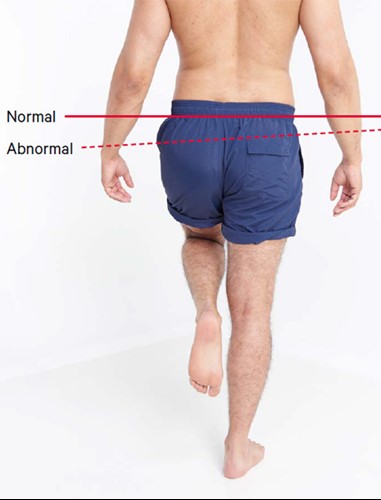
Hip size alone may not provide a complete picture of a person’s overall health or body shape. It is more meaningful to consider hip size in conjunction with other measurements, such as waist circumference or body mass index (BMI), to assess body composition and health risks. Ultimately, focusing on overall well-being, including a balanced diet, regular exercise, and maintaining a healthy weight, is more important than a specific hip measurement.
What is the average hip circumference for teenage girls?
The average hip circumference for teenage girls can vary depending on various factors such as age, height, genetics, and overall body composition. On average, the hip circumference for teenage girls typically falls within the range of 32 to 37 inches (81 to 94 centimeters). However, it’s important to note that individual measurements can vary significantly. It’s crucial to remember that body shape and size differ among individuals, and there is no one “ideal” hip circumference.
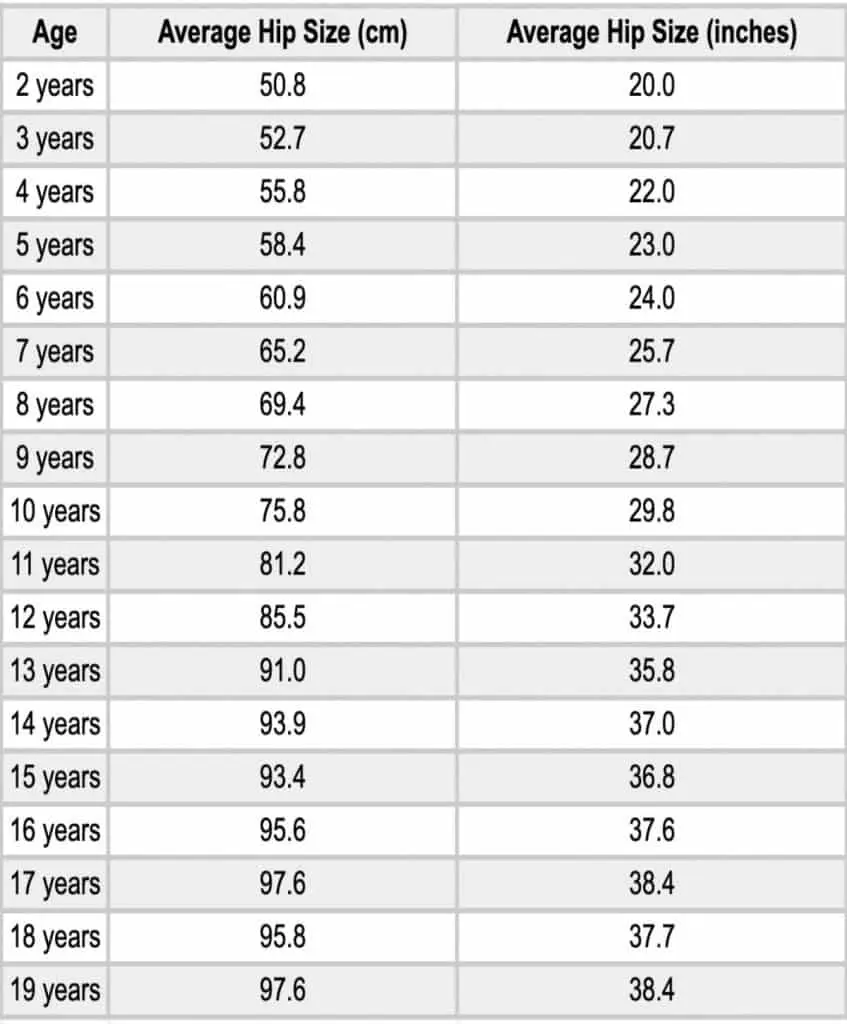
It’s more important to focus on overall health and body positivity rather than comparing oneself to specific measurements. If you have concerns about your health or body measurements, it’s always a good idea to consult with a healthcare professional who can provide personalized guidance.
What is the average hip circumference for teenage boys?
The average hip circumference for teenage boys can vary based on factors such as age, genetics, and overall body composition. However, on average, the hip circumference for teenage boys falls within a range of approximately 85 to 100 centimeters (33 to 39 inches).
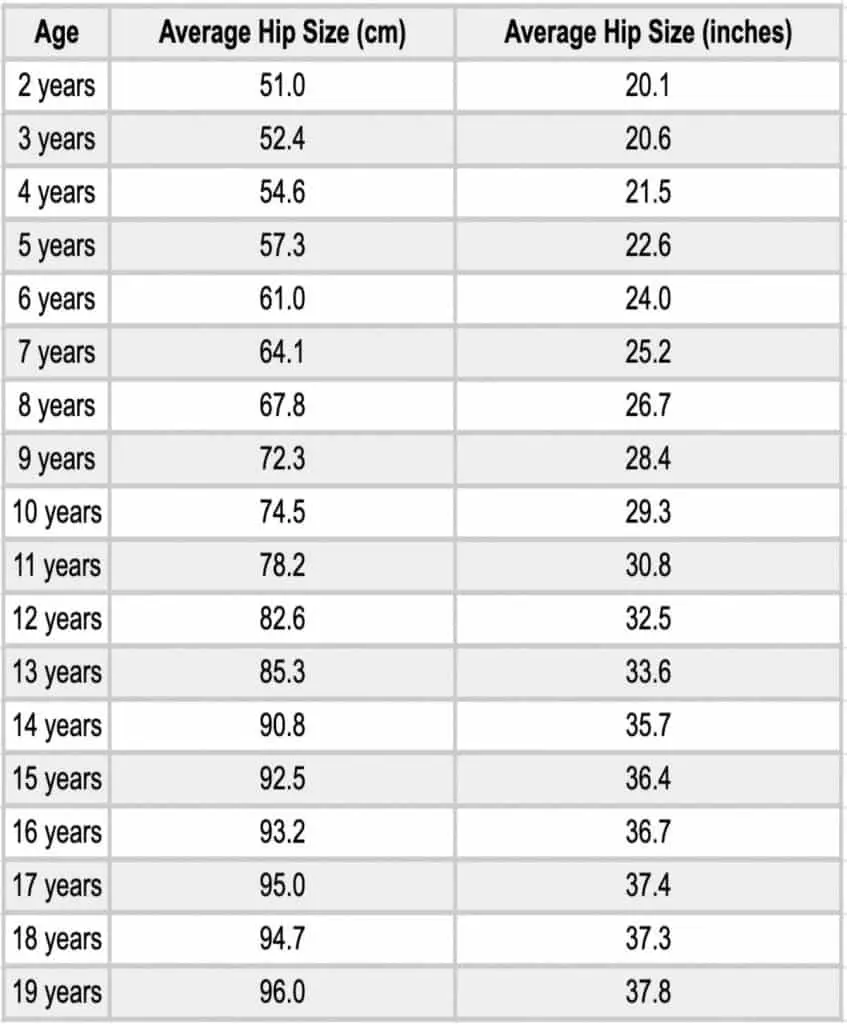
It’s important to note that these figures are general estimates and can differ among individuals. Factors such as puberty, growth spurts, and physical activity levels can influence hip circumference. If you are concerned about your hip circumference or any aspect of your health, it’s always best to consult with a healthcare professional who can provide personalized guidance and assessments.
What is the average hip width for women?
The average hip width for women can vary depending on various factors such as genetics, ethnicity, body type, and geographical location. However, it is important to note that there is no universally defined “average” hip width for women.
Hip width is typically measured at the widest part of the hips, which is usually below the waist and above the thighs. While there may be general trends or measurements observed in certain populations, it is essential to recognize the natural diversity of human bodies and the wide range of hip widths that can be considered normal and healthy.

Moreover, societal ideals of beauty and body standards can influence perceptions of what is considered “average.” It is crucial to promote body positivity and acceptance of diverse body types rather than focusing on specific measurements or trying to fit into a standardized mold. Embracing and celebrating individuality and uniqueness should be the priority when it comes to body image.
What is the average male hip width?
The average male hip width can vary significantly depending on factors such as genetics, ethnicity, and body composition. However, on average, the hip width of adult males typically ranges from 12 to 15 inches (30 to 38 centimeters). It’s important to note that these figures are approximate and may not apply to every individual.
Hip width is influenced by several factors, including bone structure and the distribution of muscle and fat in the hip area. Additionally, different cultures and regions may have varying average hip widths due to genetic and environmental factors.

It’s worth mentioning that focusing on average hip width alone may not provide a comprehensive understanding of an individual’s body shape or overall health. Body measurements can vary greatly among individuals, and it’s more important to prioritize overall well-being, including a balanced diet, regular exercise, and maintaining healthy body weight.
Hip size charts
Hip size charts are useful tools for determining the appropriate clothing size or measuring the circumference of hips in both men and women. These charts provide standardized measurements that can help individuals find the right fit and ensure comfortable clothing.
Female hip size chart (clothing)
For women, a female hip size chart for clothing typically includes measurements for different sizes, such as small, medium, large, and extra-large. These measurements are usually based on the circumference of the hips in inches or centimeters. By comparing their hip measurements to the chart, women can determine their size and choose clothing that will fit them well.
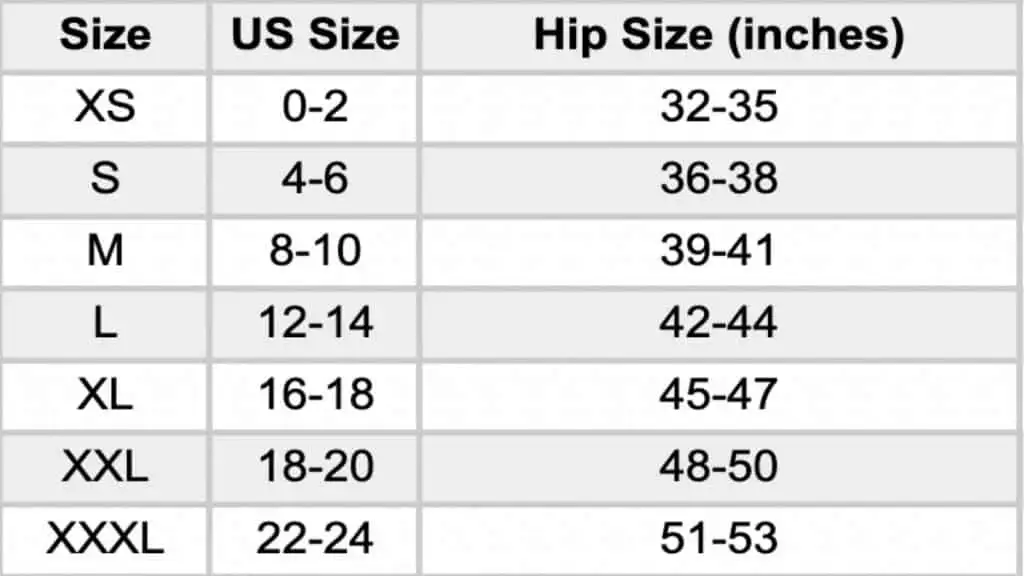
Hip size chart for women (circumference)
In addition to clothing-specific hip size charts, there are also general hip size charts for women that provide a range of hip circumferences and corresponding sizes. These charts may be more comprehensive and can be useful when purchasing clothing from different brands or when precise measurements are required. They offer a broader range of sizes and measurements to accommodate individual body types and preferences.
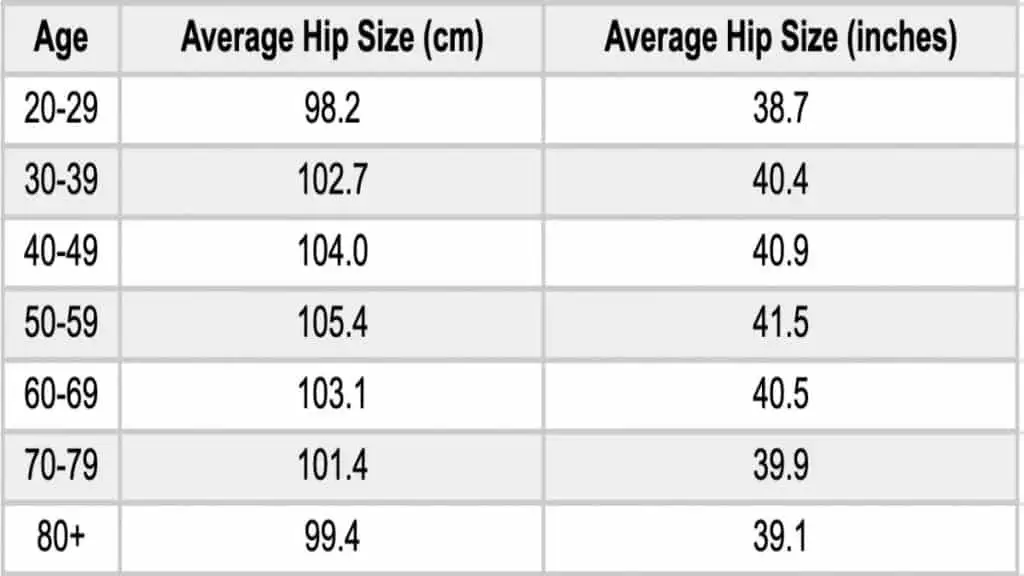
Male hip size chart (circumference)
Similar to the female charts, there are male hip size charts that provide measurements for men’s hip circumferences. These charts are particularly helpful when purchasing pants or other bottom-wear, ensuring a proper fit around the hips and waist. The measurements are usually given in inches or centimeters, allowing men to select the most suitable size for their body shape.

Female hip width size chart
A female hip width size chart provides measurements for the width of the hips in women. It helps individuals determine the width of their hips, which is especially useful for clothing like skirts or dresses that require a specific fit around the hips. By referring to the chart, women can find the appropriate size that accommodates their hip width and ensures a comfortable and flattering fit. It is important to note that individual body shapes can vary, so trying on clothing is always recommended for the best fit.
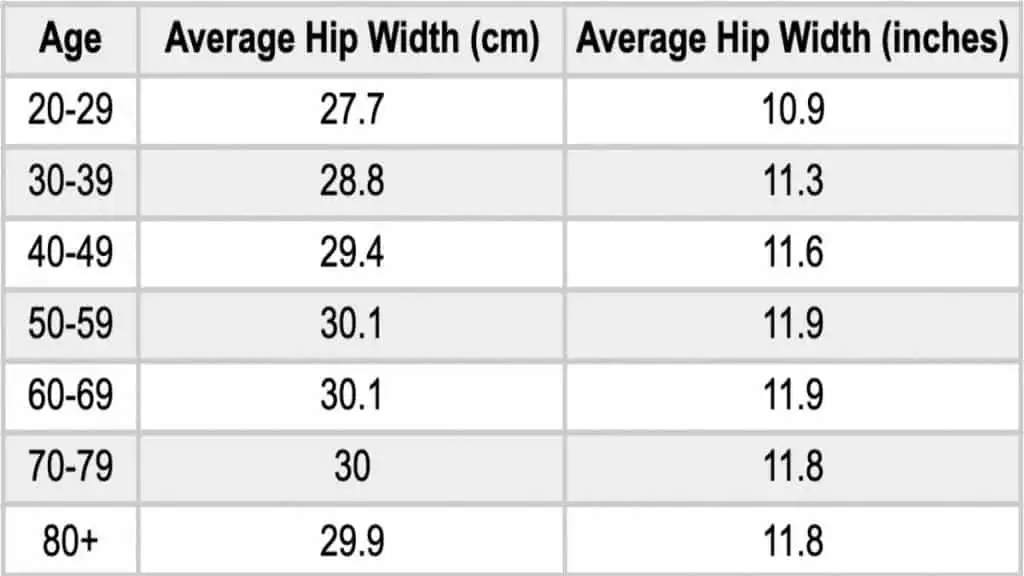
Male hip width chart
A male hip width chart provides measurements for the width of the hips in men. This chart is particularly helpful when it comes to selecting pants or other bottomwear that require a proper fit around the hips. By referring to the chart, men can find the appropriate size that accommodates their hip width, ensuring comfort and a flattering appearance. It’s important to note that individual body shapes can vary, so trying on clothing or taking accurate measurements is recommended to ensure the best fit.
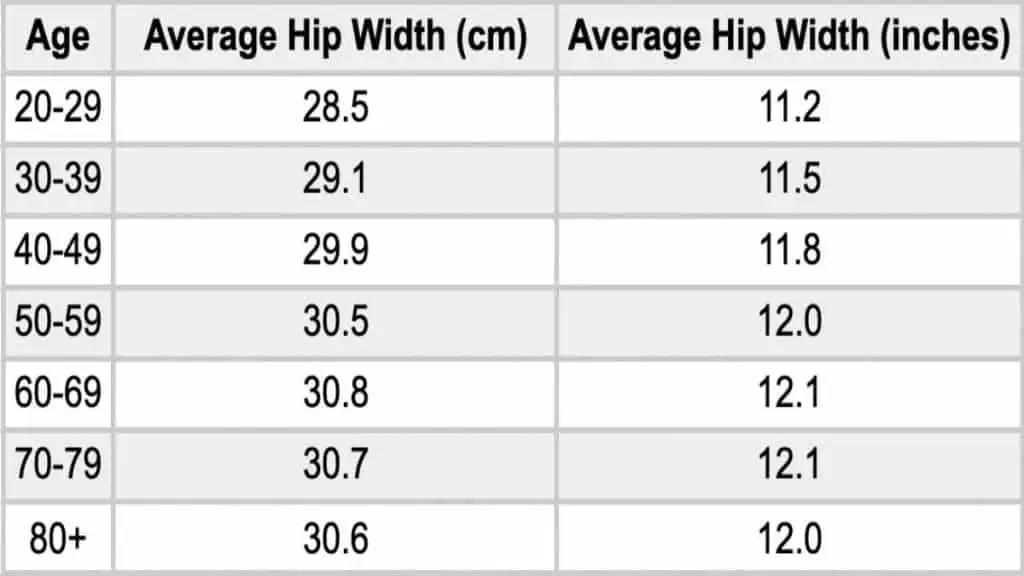
To sum up, hip size charts are valuable resources for both men and women when it comes to finding the right clothing size or measuring hip circumferences. Whether it’s for determining the appropriate size or ensuring a proper fit, these charts provide standardized measurements that help individuals make informed decisions and feel comfortable in their clothing choices.
How to measure your hips (circumference)?

Measuring your hip circumference is a simple process that can provide useful information about your body shape and size. To measure your hips accurately, follow these steps:
- Find a flexible measuring tape: Use a soft measuring tape that can easily wrap around your hips.
- Locate your hip bones: Stand straight with your feet together and find the bony protrusions on the sides of your hips. These are known as your hip bones.
- Position the tape: Wrap the measuring tape around the fullest part of your hips, ensuring that it remains parallel to the floor. It should pass over your hip bones.
- Take the measurement: Make sure the tape is snug but not too tight. Take note of the measurement at the point where the end of the tape overlaps with the rest.
- Repeat for accuracy: To ensure accuracy, take multiple measurements and calculate the average.
Remember that measuring your hips is just a numerical representation and does not define your worth or beauty. It can, however, be a helpful tool for tracking progress when it comes to fitness goals or clothing sizes.
How to measure your hip width?
Measuring your hip width is a simple process that can be done using a flexible tape measure. Follow these steps to accurately measure your hip width:

- Stand up straight with your feet slightly apart.
- Locate the widest part of your hips. This is typically around the area where your hip bones protrude.
- Wrap the tape measure around your hips, making sure it stays parallel to the floor.
- Hold the tape measure snugly against your skin without pulling it too tightly.
- Take note of the measurement at the point where the end of the tape measure meets the rest of it.
- Read the measurement in inches or centimeters, whichever unit you prefer.
- Repeat the process two or three times to ensure accuracy and consistency.
- Take the average of the measurements you obtained to get a more precise hip width measurement.
Remember that measuring your hip width can be useful for determining clothing sizes or tracking changes in your body shape over time.
Hip measurement FAQ
Immerse yourself in a comprehensive hip measurement FAQ that encompasses a wealth of knowledge on hip size. Delve into a treasure trove of information, where you can explore every facet and intricacy associated with measuring your hips. Discover the significance of hip size and its implications for fashion, health, and body composition.
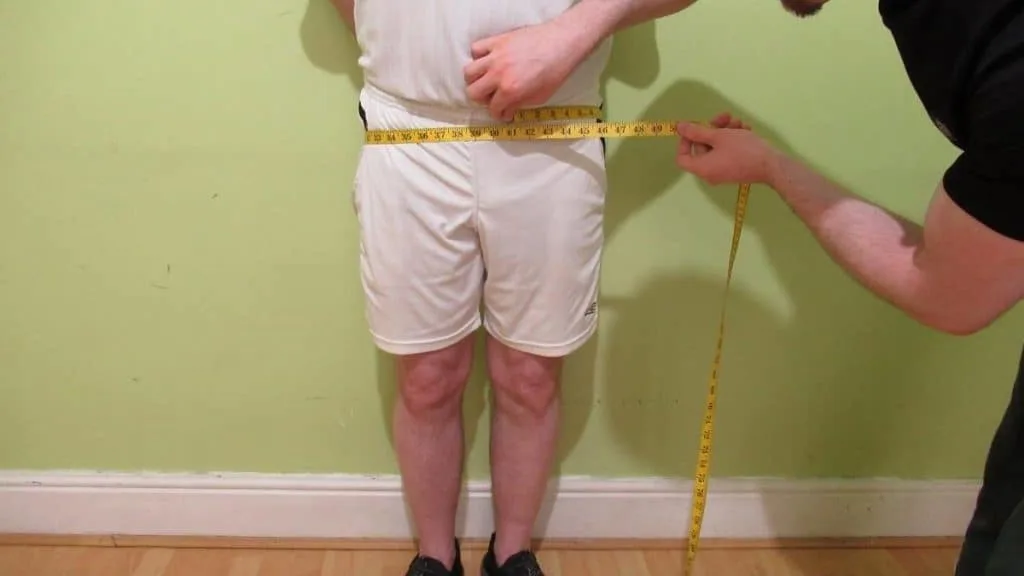
From practical tips on accurate measurement techniques to understanding the diversity of hip shapes and their impact on overall appearance, this indispensable resource is your go-to guide for unlocking the secrets behind hip size.
What is the hip size?
The hip size refers to the circumference or width of the hips, which is a measure of the widest part of the pelvic region. It is commonly used as a measurement for clothing sizes, especially for bottoms such as pants, skirts, and shorts. Hip size is an important factor in determining the fit and comfort of these garments, as it helps ensure that they can be worn comfortably around the hips and buttocks.
To measure hip size, a tape measure is typically used to wrap around the fullest part of the hips, which is usually around the buttocks. The measurement is taken in inches or centimeters, depending on the preferred unit of measurement. Hip size can vary significantly among individuals due to factors such as genetics, body shape, and overall body composition.
Knowing your hip size is particularly useful when shopping for clothing online or when trying to determine the right size for a particular garment. It is one of the key measurements taken into account, along with waist size and inseam length, to find the best fit.
Is there such a thing as the perfect hip size for a woman?
No, there is no such thing as the perfect hip size for a woman. The concept of an ideal or perfect hip size is subjective and varies greatly across different cultures, societies, and personal preferences. Beauty standards and body ideals differ widely, and what is considered attractive or desirable in terms of hip size can change over time.
It’s important to recognize and celebrate the diversity of body shapes and sizes among women. Every individual has a unique body composition influenced by factors such as genetics, hormones, and lifestyle. Women naturally come in various shapes and sizes, and each one is beautiful in her own way.

Focusing on achieving a specific hip size or conforming to societal ideals can lead to body image issues and self-esteem problems. Instead, it’s essential to prioritize overall health and well-being by maintaining a balanced lifestyle that includes regular physical activity, a nutritious diet, and positive body acceptance. Embracing and appreciating one’s natural body shape is key to feeling confident and comfortable in one’s own skin.
What is the ideal hip size for a 5’5″ woman?
There is no universally defined ideal hip size for a 5’5″ woman or any specific height. Hip size, like body proportions, varies greatly among individuals and is influenced by factors such as genetics, bone structure, muscle mass, and body composition.
Different cultures, preferences, and standards shape how people view the ideal hip size. Beauty varies for everyone, and there is no one-size-fits-all “ideal.”

Rather than focusing on an arbitrary ideal, it is more beneficial to prioritize overall health and well-being. Maintaining a balanced lifestyle that includes regular exercise, a nutritious diet, and self-care is more important than conforming to specific measurements. It is essential to embrace and appreciate your unique body shape and size, fostering self-confidence and body positivity.
What is a healthy hip size?
Determining a specific healthy hip size can be challenging as it varies among individuals due to factors such as body composition, genetics, and overall body shape. However, maintaining a healthy hip-to-waist ratio is often considered more important than focusing solely on hip size. The hip-to-waist ratio is a measure of body fat distribution and has been linked to various health indicators.
Research suggests that for women, a waist-to-hip ratio of around 0.7 is often associated with good health and fertility. This means that the circumference of the waist should be approximately 70% of the circumference of the hips. For men, a waist-to-hip ratio of around 0.9 is considered healthy.

It’s important to note that these ratios are general guidelines and may not apply to everyone. It’s essential to prioritize overall health and well-being rather than striving for a specific hip size or ratio. To attain and sustain a healthy body composition, it’s crucial for individuals to incorporate regular physical activity and a well-balanced diet and seek guidance from healthcare experts.
Where should you measure your hips?
When measuring your hips, it’s important to find the correct anatomical landmarks to ensure accurate results. The hip measurement is typically taken around the widest part of your buttocks. To find this point, follow these steps:
- Stand up straight with your feet together and relax your muscles.
- Place your hands on your hips and slide them down until they rest on the bony prominences on the sides of your hips. These prominences are called your hip bones or iliac crests.
- Take a measuring tape and wrap it around your body, passing over the fullest part of your buttocks and the hip bones.
- Make sure the measuring tape is parallel to the floor and snug against your body without compressing your skin.
By measuring at this location, you are capturing the widest part of your hips accurately. It’s important to note that when comparing measurements over time, it’s best to measure consistently using the same technique and location to track any changes.
What is the difference between a hip-width measurement and a hip circumference measurement?
Hip width and hip circumference are different ways to measure hip size and provide unique information. Hip width refers to the distance between the outer edges of the hips, typically measured across the widest part of the pelvic bones.
It provides an indication of the skeletal structure and can be useful for determining body proportions and clothing sizes. Hip width is commonly measured using a tape measure, with the measurement taken from one side of the hip to the other.

On the other hand, hip circumference refers to the measurement around the fullest part of the hips and buttocks. It is obtained by wrapping a tape measure around the body horizontally, encompassing the widest area. Hip circumference assesses body fat distribution and helps determine the risk of conditions like cardiovascular disease or diabetes.
In summary, hip-width focuses on the width of the bony structure, while hip circumference captures the girth of the hips and is more related to body composition.
Should you measure men’s hips and women’s hips differently?
The measurement of hips is typically influenced by gender norms and clothing design rather than inherent anatomical differences. In general, there is no need to measure men’s and women’s hips differently. The basic approach to hip measurement remains the same for both genders.
The hip measurement is typically taken at the widest part of the hips, regardless of gender. This measurement is useful for various purposes, such as determining clothing size, designing garments, or assessing body proportions. However, it’s important to note that body shape and distribution of fat can vary widely among individuals, irrespective of gender.

It’s really important to treat everyone fairly and not say that boys or girls should look a certain way. We should measure hips in a way that works for everyone, no matter how they identify. This way, we can include and respect everyone, no matter their body shape or size.
How can you measure your hips without a tape measure?
If you don’t have a tape measure available, there are a few alternative methods you can use to measure your hips:
- String or Ribbon Method: Take a piece of string or ribbon and wrap it around the widest part of your hips. Mark the point where the string meets and then measure the length with a ruler or any other standard measuring tool.
- Paper Method: Take a strip of paper and wrap it around your hips, just like you would with a tape measure. Make a mark where the paper overlaps, and then measure the length with a ruler.
- Use a Non-Stretchy Cord: If you have a non-stretchy cord or wire available, wrap it around your hips and mark the point where it overlaps. Straighten the cord and measure the length with a ruler.
Remember to keep the measuring tool parallel to the ground and snug but not too tight when taking measurements. However, these methods may not be as accurate as using a tape measure. Therefore, they can provide you with a rough estimation of your hip measurement.
What is the average hip size by height?
The average hip size can vary based on several factors, including height. However, it is important to note that body measurements can differ greatly among individuals. Also, there is no universally standard hip size for a specific height range.
Body proportions can vary significantly based on genetics, lifestyle, and other factors. While height can influence body shape to some extent, it does not necessarily determine hip size. Even if people are the same height, their hip sizes can be different. The size can be different because their bones, muscles, and bodies are made in special ways.
To learn about average hip sizes, consult reliable sources like health and fitness databases or studies from reputable organizations. Keep in mind that these averages are often presented as ranges and may not be applicable to everyone. It is always best to focus on maintaining a healthy and balanced lifestyle rather than comparing oneself to specific size standards.
Should you aim for a normal hip measurement?
When it comes to hip measurements, there is no universal “normal” or ideal size that applies to everyone. Hip size can vary greatly depending on factors such as genetics, body composition, and overall body shape.
Instead of focusing on achieving a specific hip measurement, it’s more important to prioritize overall health and well-being. Eating good food, moving your body a lot, and living healthy is important for having a strong body, including your hips.
It’s important to know that sometimes people say that only one kind of body is beautiful, but that’s not true. Every person’s body is special, and what’s most important is feeling good, happy, and healthy in your own body. Don’t let anyone tell you that you have to look a certain way. You are amazing, just the way you are!

Talk to a doctor or nurse if you’re concerned about your hip size or body appearance. They can help you and give you advice that fits your own body and what you need. They’re there to help you feel your best!
Conclusion
It’s super important to be fair to everyone and not say that boys or girls should look a certain way. We should measure hips in a way that works for everyone, no matter how they feel inside. This way, we can include and respect everyone, no matter how their bodies look or how big or small they are. But it’s important to know that there’s no one “perfect” size for hips. Beauty and body standards differ across cultures, and embracing body positivity and self-acceptance is key.
Hip size charts are helpful tools for finding the right clothing size and ensuring a comfortable fit. To measure your hips, find the widest part of your buttocks and use a flexible tape to measure around it.
Focus on being healthy, living balanced, and embracing your unique body shape rather than worrying about specific measurements. Embrace your individuality and strive for self-improvement and personal growth rather than chasing an arbitrary ideal.
References
- Lassek, W. D., & Gaulin, S. J. (2008). Waist-hip ratio and cognitive ability: is gluteofemoral fat a privileged store of neurodevelopmental resources?. Evolution and Human Behavior, 29(1), 26-34.
- Singh, D., & Singh, D. A. (2011). Shape and significance of feminine beauty: An evolutionary perspective. Sex Roles, 64(9-10), 723-731.
- Swami, V., Tovée, M. J., & Furnham, A. (2007). Body mass index, waist-to-hip ratio, and waist-to-chest ratio as predictors of women’s health and attractiveness. Body Image, 4(2), 315-322.
- Flegal, K. M., Kit, B. K., Orpana, H., & Graubard, B. I. (2013). Association of all-cause mortality with overweight and obesity using standard body mass index categories: a systematic review and meta-analysis. JAMA, 309(1), 71-82.